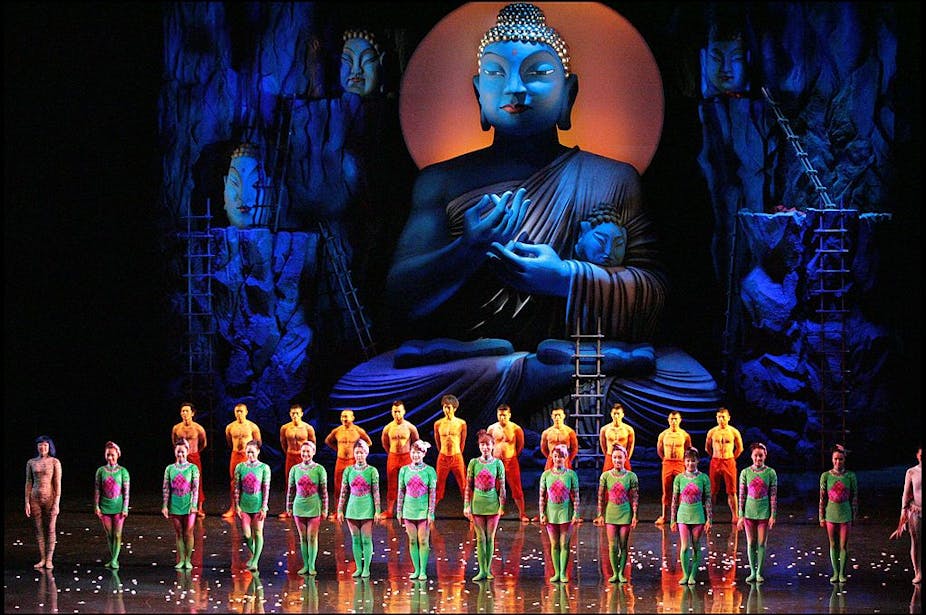by JI HAO

One summer afternoon in the late 1980s, my mother and I passed by a tea house on our trip out of town. The crowded building was usually a boisterous place filled with chatter, laughter, and the happy, clacking shuffle of mahjong tiles. At the moment we were passing, however, a great hush came over the teahouse: People were held spellbound by the black-and-white glow of a small TV in a corner, playing an episode of the series “Journey to the West.”
The TV series was adapted from a 16th century Chinese novel with the same title that has undergone numerous adaptations and has captured the imagination of Chinese people to this day. Like many kids in China, I was fascinated by the magic Monkey King, the beloved superhero in the novel, who went through amazing adventures with other pilgrims in their quest for Buddhist scriptures. While I had to quickly walk by the teahouse in order to catch our bus that day, this moment flashed back to me from time to time, making me wonder what made “Journey to the West” so fascinating for people of all ages and backgrounds.
After graduating from college, I embarked on the next chapter of my academic journey in the United States and reconnected with “Journey to the West” from a different perspective. Now, as a scholar with expertise in traditional Chinese literature, I am interested in the development of literary and cultural traditions around the story, including how it has been translated and reimagined by many artists.
While deeply enmeshed in Chinese traditions, the story also resonates with readers from diverse cultures. “Journey to the West” creates shared ground by highlighting the quest for a common humanity, epitomized by its best-loved character, the Monkey King – a symbol of the human mind.
Scholars usually trace the beginning of this literary tradition to a Buddhist monk, Xuanzang, who set out on an epic pilgrimage to India in 627 C.E. He was determined to consult and bring back Sanskrit copies of Buddhist scriptures, rather than rely on previous Chinese translations. He did so after nearly 17 years and devoted the rest of his life to translating the scriptures.
One journey, many stories
The journey has inspired a wide variety of representations in literature, art and religion, making a lasting impact on Chinese culture and society. Legends began to emerge during Xuanzang’s lifetime. Over centuries, they gradually evolved into a distinct tradition of storytelling, often focused on how Xuanzang overcame obstacles with the help of supernatural companions.
This culminated in a 16th century Chinese novel, “Journey to the West.” By this point, the hero of the story had already shifted from Xuanzang to one of his disciples: the Monkey King of Flower-Fruit Mountain, who serves as Xuanzang’s protector. The Monkey King possesses strong magical powers – transforming himself, cloning himself and even performing somersaults that fly him more than 30,000 miles at once.
Despite this novel’s dominance, the broader tradition around “Journey to the West” encompasses a wide variety of stories in diverse forms. The canonic novel itself grew out of this collective effort, and its authorship is still debated – even as it continues to inspire new adaptations.
The deeper journey
Central to all Journey to the West stories is a theme of pilgrimage, which immediately raises a question regarding the nature of the novel: What is the journey really about?
Centuries-long debates about the journey’s deeper message center on the 16th century novel. Traditional commentators in late imperial China adopted a variety of approaches to the novel and underscored its connections with different religious and philosophical doctrines: Confucianism, Daoism, Buddhism and syntheses of those teachings.
For example, all these teachings highlight the role of the “xin” – a Chinese word for mind and heart – in self-cultivation. While Confucian readers might see the plot of “Journey to the West” as the quest for a more moral life, Buddhists might decipher it as an inward journey toward enlightenment.
The Conversation for more
